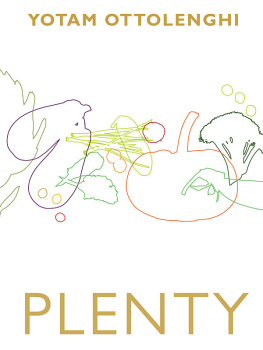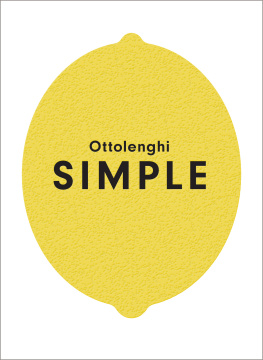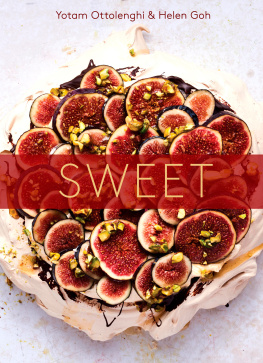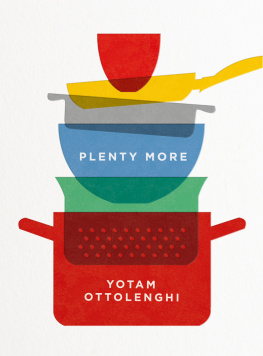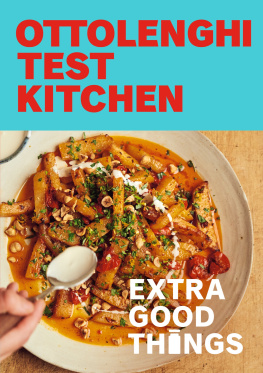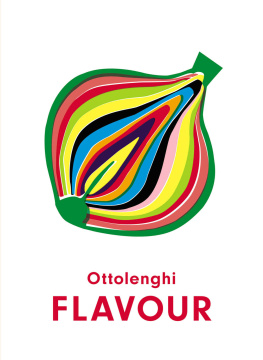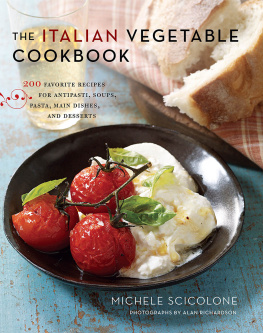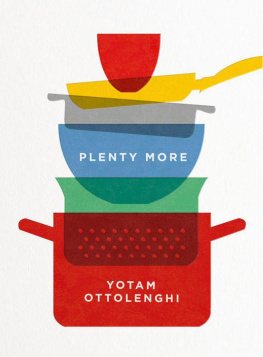9781446407134
Published in 2010 by Ebury Press, an imprint of Ebury Publishing
Ebury Publishing is a division of the Random House Group
Text Yotam Ottolenghi 2010
Photography by Jonathan Lovekin
Yotam Ottolenghi has asserted his right to be identified as the author of this Work in accordance with the Copyright, Designs and Patents Act 1988
All rights reserved. No part of this publication may be reproduced, stored in a retrieval system, or transmitted in any form or by any means, electronic, mechanical, photocopying, recording or otherwise, without the prior permission of the copyright owner
The Random House Group Limited Reg. No. 954009
Addresses for companies within the Random House Group can be found at www.randomhouse.co.uk
A CIP catalogue record for this book is available from the British Library
Design: Two Associates
Photographer: Jonathan Lovekin
Copy editor: Norma Macmillan
ISBN: 9780091933685
To buy books by your favourite authors and register for offers visit www.rbooks.co.uk
YOTAM OTTOLENGHI
PLENTY

Contents
Introduction

Ill start with something as simple and unassuming as rice. When I try to think of all the uses for this grain I immediately go dizzy with the countless possibilities within and between cultures, pairing with other ingredients, all the types of rice available, the methods of cooking and when you serve it, the consistency, degree of processing, home cooking, commercial uses. I think of paella, wild rice salad and ho fan noodles. I visualize arancini with their golden breadcrumb crust, Iranian saffron rice with potatoes, Chinese fried rice, rice pudding. I recall plain steamed rice my mum used to prepare for me when I had a bad tummy, with only a little bit of butter stirred in at the end.
I can then move on to another cereal grain such as wheat and think of things we do with flour dumplings, pastas, breads, pastries or of less-processed examples like bulghar or whole wheat. My mind then wanders to the sphere of lentils, dried beans, green beans, peas. There are herbs, leaves, seeds, flowers, roots, bulbs, fruit and fungi each part of a separate little universe, with a million varieties and variations within it.
What I am getting at is how lucky we are (although unfortunately not all of us) to be living and cooking in a world that offers such a spectrum of ingredients and so many culinary heritages to draw on. And this is what gets me excited the multitude of ingredients cooked and processed by so many people in so many ways with so many different purposes.
The New Vegetarian
Back in 2006, when I was first approached by the Guardian to write a vegetarian column in their Weekend magazine, I was slightly hesitant. After all, I wasnt a vegetarian. The issue wasnt close to my heart either and I had never given it much thought. Still, I understood the reasoning behind the Guardians approach. Ottolenghi had become famous for what we did with vegetables and grains, for the freshness and originality of our salads, and it only made sense to ask me to share this with vegetarian readers.
It took me a while, though, to get to grips with my title, The New Vegetarian, and it made some Guardian readers extremely unhappy to learn that the new vegetarian wasnt a vegetarian at all. A couple of angry letters to the editor stick in my mind and an incident where I suggested serving a salad with some barbecued lamb chops. Unfortunately, my editor missed this too.
But with time the task has become more natural to me. Ottolenghis vegetarian image was rightly based on the fact that both Sami Tamimi the other creative force behind the company and co-author of Ottolenghi: The Cookbook and I were brought up in Israel and Palestine and were exposed to the multitude of vegetables, pulses and grains that are celebrated in the regions different cuisines.
The food I had growing up was a huge mixture of diverse culinary cultures European at home and Middle Eastern all around with an abundance of easily sourced fresh ingredients. The greengrocers where my mother does her shopping in the neighbouring Arab village always reminds me of this. It sells a fantastically fresh abundance of local and seasonal fruit and veg, what I call real fruit and veg because they look real, taste real and are grown by real people that is, Arab or Jewish farmers and not nameless farmers across the globe. It sells cucumbers, kohlrabis, figs, pomegranates, apricots, almonds and pistachios, as well as herbs from the area, local halva, olive oil and much more. Both my parents used this wealth daily to prepare real meals of real food, which is their food.
This multitude of ingredients and ways of making miracles with them have given me the perfect tools for making up dishes and turning them into recipes. This is also why vegetarian cooking didnt turn out to be a chore for me. I like meat and I like fish but I can easily cook without them. My grandmothers vinegar-marinated courgettes, or the ripe figs with ewes cheese we used to down before dinner, are as substantial and as basic as any cut of meat I used to have.
Vegetarianism
Still, I am not a vegetarian and this is important to mention. I refer to meat and fish in the introductions to the recipes as I occasionally have them in the back of my mind. But I dont miss these two elements. In this book I offer dozens of solid dishes, all balanced and nurturing, that just happen to include neither fish nor meat.
Why vegetarianism then? What is the reason behind not having meat or fish? Why would people be interested in this vegetarian collection?
First, this is an assembly of my work in the Guardian over the past four years. I have often been asked by readers, whove become fed up with collecting little bits of torn paper, to assemble it all together in one volume. Most of these bits of paper are now here for them, plus plenty more new recipes I havent published before.
But more to the point, people have very different motivations for wanting to cook vegetarian recipes. Some choose unequivocally to exclude meat from their diet. Many do this for moral or other personal reasons, which I both understand and respect. These people may find allusions to non-vegetarian ingredients disturbing. Some may not like my extensive use of eggs and dairy products. Many would probably be put off by my advocating the use of Parmesan and other continental cheeses that almost always include animal rennet in their production. My answer to all these objections is that I can only be myself and cook what I like to eat. I believe that most seasoned vegetarians would know which elements in the book to adopt and which to disregard, which suit their type of vegetarianism and which dont.
A second group of people, which is increasingly growing in numbers, are pragmatic vegetarians, those who have excluded meat or fish from their diet to some degree, but are not completely put off by the notion. This group would include people who are concerned with the health implications of eating meat. It also consists of people who would like to eliminate or reduce their consumption of meat and fish due to the environmental implications. They are put off by what mass-scale farming does to the land and the sea, how growing numbers of cattle herds contribute to the growth in greenhouse gases and the warming up of the planet. Many long for a time when meat was precious, a reason for celebration rather than a cheap commodity, a time when farm animals were highly regarded and their slaughter more sensible.

